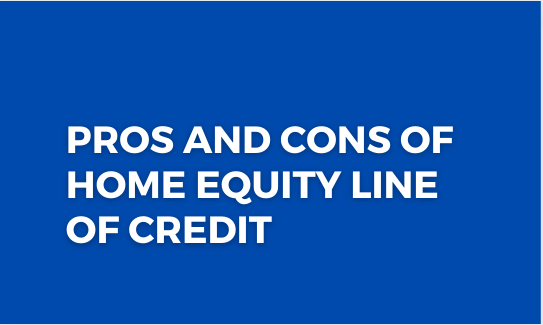A home equity line of credit (HELOC) is a financial product that allows homeowners to borrow money using their home equity as collateral. Home equity refers to the current market value of a property minus any outstanding mortgage balance. Below are pros and cons of a home equity line of credit:
Pros:
- Access to funds: HELOC provides homeowners with a convenient source of funds for various purposes, such as home improvements or debt consolidation.
- Lower interest rates: HELOCs often offer lower interest rates compared to other forms of borrowing, such as credit cards or personal loans.
- Flexibility in borrowing: Homeowners can borrow and repay funds from a HELOC multiple times, giving them flexibility in managing their finances.
- Potential tax advantages: In some cases, the interest paid on a HELOC may be tax-deductible, providing potential tax benefits.
- Interest-only payment option: HELOCs may allow borrowers to make interest-only payments during the draw period, reducing monthly financial obligations.
- Emergency funds: A HELOC can serve as a safety net for unexpected expenses or emergencies, providing quick access to funds.
- Adjustable borrowing limits: The borrowing limit of a HELOC may increase as the homeowner’s equity in the property grows, offering greater borrowing potential.
- Opportunity for home appreciation: As property values increase over time, homeowners with a HELOC may benefit from additional equity.
- Consolidating higher-interest debt: Homeowners can use a HELOC to consolidate and pay off high-interest debts, potentially saving money on interest payments.
- Home improvement financing: A HELOC can be an effective way to finance home renovation projects and increase the value of the property.
- Gradual repayment: Borrowers have the option to repay the borrowed funds gradually over time, making it more manageable for budgeting.
- Access to better loan terms: The availability of a HELOC may improve the chances of getting favorable loan terms for other borrowing needs.
- Investment opportunities: Homeowners can use a HELOC to invest in other ventures or assets that may generate a higher return.
- Preservation of existing mortgage terms: Taking out a HELOC does not affect the terms or interest rate of the existing mortgage.
- Bridging financial gaps: A HELOC can help homeowners bridge financial gaps during periods of unemployment or income fluctuations.
- College tuition financing: HELOCs can be utilized to fund education expenses, such as college tuition, providing an alternative to student loans.
- Debt management tool: A HELOC can be used strategically to manage and pay off debt, especially if the interest rates are favorable.
- Improving credit score: Responsible management of a HELOC, including making timely payments, can help improve an individual’s credit score over time.
- Convenience and ease of use: Accessing funds from a HELOC is often simple and convenient, with options such as online banking or checks.
- Opportunity for investment diversification: By using a HELOC, homeowners can diversify their investments beyond real estate.
Cons:
- Risk of foreclosure: Failure to repay a HELOC may result in the lender foreclosing on the property.
- Variable interest rates: HELOCs often have variable interest rates, which means that the monthly payments can fluctuate based on market conditions.
- Hidden fees and costs: Homeowners may encounter various fees and costs associated with a HELOC, such as application fees, annual fees, or early closure fees.
- Risk of overborrowing: Easy access to funds through a HELOC may tempt homeowners to borrow more than they can comfortably repay.
- Reduction in home equity: Borrowing against home equity through a HELOC reduces the available equity in the property, potentially impacting future financing options.
- Resetting of interest rates: Some HELOCs have a draw period followed by a repayment period, during which the interest rate may reset, leading to higher monthly payments.
- Limited borrowing capacity: The amount a homeowner can borrow through a HELOC is limited by the available equity in the property.
- Impact on credit score: Borrowing against a HELOC can affect an individual’s credit score, especially if the utilization ratio is high or if payments are missed.
- Potential for excessive spending: The availability of a HELOC may tempt homeowners to overspend or make impulsive purchases.
- Market fluctuations affecting home equity: Changes in the real estate market can impact the value of the property and, consequently, the available equity in a HELOC.
- Lengthy repayment period: Repayment of a HELOC can take several years or even decades, potentially resulting in long-term debt obligations.
- Inability to sell the property: If a homeowner has an outstanding balance on a HELOC, selling the property may require paying off the loan in full.
- Limited use for non-property-related expenses: HELOC funds are typically intended for home-related expenses, limiting their use for other purposes.
- Potential for negative equity: In a declining real estate market, homeowners may face negative equity, where the outstanding loan balance exceeds the property’s value.
- Reliance on property value: The borrowing capacity of a HELOC is tied to the value of the property, making it susceptible to market fluctuations.
- Limited availability for certain property types: Not all properties are eligible for a HELOC, such as co-ops or investment properties.
- Prepayment penalties: Some HELOCs may include prepayment penalties if borrowers choose to pay off the loan before a certain period.
- Potential for abuse or misuse: Irresponsible borrowing and mismanagement of a HELOC can lead to financial difficulties and exacerbate debt problems.
- Complexity of repayment terms: The terms and conditions of a HELOC can be complex, requiring careful understanding and management to avoid financial pitfalls.
- Potential for reduced home affordability: Borrowing against home equity through a HELOC may increase the overall debt burden and reduce affordability for future homebuying.
Pros
- Access to funds
- Lower interest rates
- Flexibility in borrowing
- Potential tax advantages
- Interest-only payment option
- Emergency funds
- Adjustable borrowing limits
- Opportunity for home appreciation
- Consolidating higher-interest debt
- Home improvement financing:
- Gradual repayment
- Access to better loan terms
- Investment opportunities
- Preservation of existing mortgage terms
- Bridging financial gaps
- College tuition financing
- Debt management tool
- Improving credit score
- Improving credit score
- Opportunity for investment diversification
Cons
- Risk of foreclosure
- Variable interest rates
- Hidden fees and costs
- Risk of overborrowing
- Reduction in home equity
- Resetting of interest rates
- Limited borrowing capacity
- Impact on credit score
- Potential for excessive spending
- Market fluctuations affecting home equity
- Lengthy repayment period
- Inability to sell the property
- Limited use for non-property-related expenses
- Potential for negative equity
- Reliance on property value
- Limited availability for certain property types
- Prepayment penalties
- Potential for abuse or misuse
- Complexity of repayment terms
- Potential for reduced home affordability



